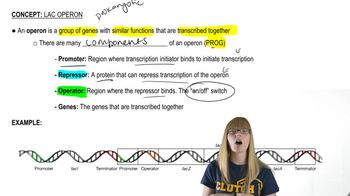Table of contents
- 1. Introduction to Genetics51m
- 2. Mendel's Laws of Inheritance3h 37m
- 3. Extensions to Mendelian Inheritance2h 41m
- 4. Genetic Mapping and Linkage2h 28m
- 5. Genetics of Bacteria and Viruses1h 21m
- 6. Chromosomal Variation1h 48m
- 7. DNA and Chromosome Structure56m
- 8. DNA Replication1h 10m
- 9. Mitosis and Meiosis1h 34m
- 10. Transcription1h 0m
- 11. Translation58m
- 12. Gene Regulation in Prokaryotes1h 19m
- 13. Gene Regulation in Eukaryotes44m
- 14. Genetic Control of Development44m
- 15. Genomes and Genomics1h 50m
- 16. Transposable Elements47m
- 17. Mutation, Repair, and Recombination1h 6m
- 18. Molecular Genetic Tools19m
- 19. Cancer Genetics29m
- 20. Quantitative Genetics1h 26m
- 21. Population Genetics50m
- 22. Evolutionary Genetics29m
13. Gene Regulation in Eukaryotes
GAL Regulation
Problem 25c
Textbook Question
Regulation of the lac operon in E. coli (see Chapter 16) and regulation of the GAL system in yeast are analogous in that they both serve to adapt cells to growth on different carbon sources. However, the transcriptional changes are accomplished very differently. Consider the conceptual similarities and differences as you address the following.
Compare and contrast the roles of the lac operon inducer in bacteria and Gal3p in eukaryotes in the regulation of their respective systems.
 Verified step by step guidance
Verified step by step guidance1
<span>Identify the role of the lac operon inducer in E. coli. The lac operon is regulated by the presence or absence of lactose, which acts as an inducer. When lactose is present, it binds to the repressor protein, causing a conformational change that prevents the repressor from binding to the operator region, thus allowing transcription of the operon.</span>
<span>Understand the role of Gal3p in the GAL system in yeast. Gal3p is a protein that, in the presence of galactose, interacts with Gal80p, relieving its inhibition on Gal4p, a transcriptional activator. This interaction allows Gal4p to activate transcription of the GAL genes.</span>
<span>Compare the mechanisms: Both systems involve an inducer molecule (lactose in bacteria, galactose in yeast) that interacts with a regulatory protein (repressor in bacteria, Gal3p in yeast) to relieve repression and allow transcription.</span>
<span>Contrast the systems: In the lac operon, the inducer directly interacts with the repressor to prevent it from binding to DNA. In the GAL system, Gal3p does not bind directly to DNA but instead interacts with another protein (Gal80p) to relieve repression on a transcriptional activator (Gal4p).</span>
<span>Consider the cellular context: The lac operon is a prokaryotic system, which typically involves simpler regulatory mechanisms, while the GAL system is eukaryotic, involving more complex protein-protein interactions and regulatory layers.</span>
Recommended similar problem, with video answer:
 Verified Solution
Verified SolutionThis video solution was recommended by our tutors as helpful for the problem above
Video duration:
2mPlay a video:
Was this helpful?
Key Concepts
Here are the essential concepts you must grasp in order to answer the question correctly.
Lac Operon
The lac operon is a set of genes in E. coli that are involved in the metabolism of lactose. It is regulated by the presence or absence of lactose, which acts as an inducer. When lactose is present, it binds to the repressor protein, allowing transcription of the genes necessary for lactose utilization. This system exemplifies prokaryotic gene regulation, where the operon structure allows for coordinated control of multiple genes.
Recommended video:
Guided course

Lac Operon Overview
Gal3p Protein
Gal3p is a regulatory protein in yeast that plays a crucial role in the GAL gene system, which is responsible for the metabolism of galactose. Unlike the lac operon, Gal3p functions as a sensor for galactose, binding to it and activating transcription of the GAL genes. This mechanism highlights the differences in eukaryotic regulation, where proteins like Gal3p integrate signals to modulate gene expression in response to environmental changes.
Recommended video:
Guided course

Proteins
Transcriptional Regulation
Transcriptional regulation refers to the mechanisms that control the transcription of genes, determining when and how much of a gene product is made. In both the lac operon and the GAL system, transcriptional regulation is essential for adapting to different carbon sources. However, the processes differ significantly; the lac operon relies on a simple repressor-inducer interaction, while the GAL system involves more complex interactions between multiple proteins and regulatory elements, reflecting the intricacies of eukaryotic gene regulation.
Recommended video:
Guided course

Eukaryotic Transcription

 3:55m
3:55mWatch next
Master GAL Regulation with a bite sized video explanation from Kylia Goodner
Start learningRelated Videos
Related Practice


